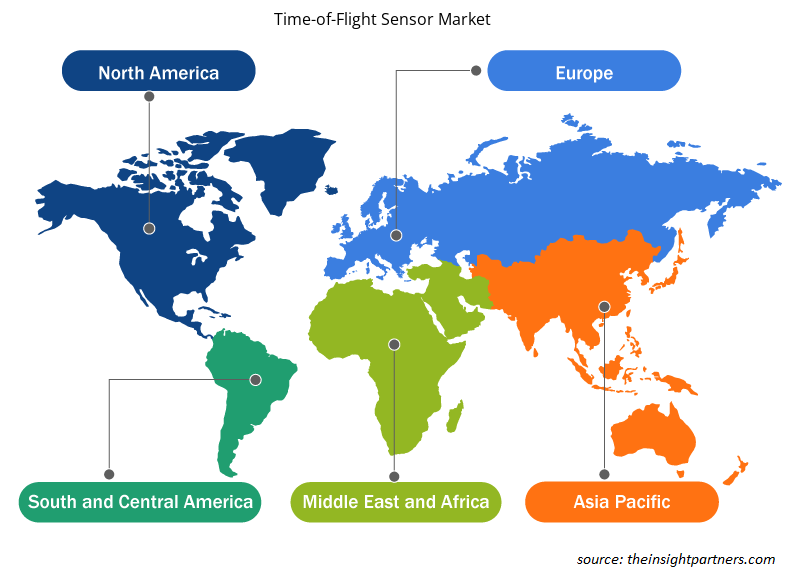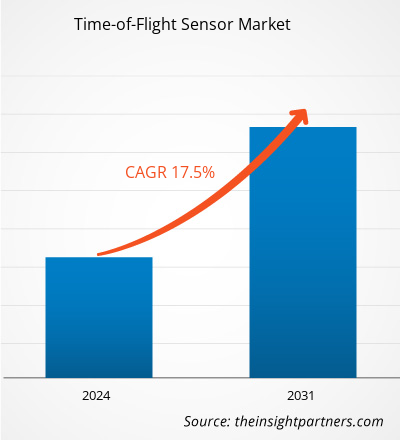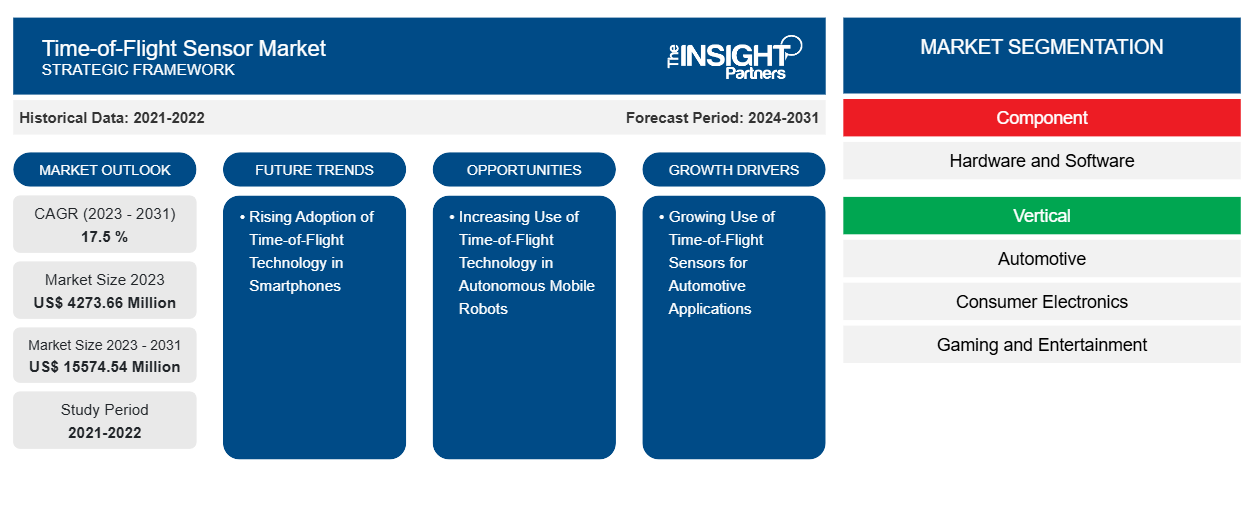Si prevede che la dimensione del mercato dei sensori time-of-flight raggiungerà i 15574,54 milioni di dollari entro il 2031, rispetto ai 4273,66 milioni di dollari del 2023. Si prevede che il mercato registrerà un CAGR del 17,5% nel periodo 2023-2031. È probabile che la crescente adozione della tecnologia time-of-flight negli smartphone rimanga una tendenza chiave nel mercato.
Analisi di mercato dei sensori del tempo di volo
La domanda di sensori ToF è in aumento a causa del loro crescente utilizzo nel settore automobilistico. La tecnologia è utilizzata per monitorare il comportamento del conducente, il che aiuta a prevenire incidenti stradali e migliorare la sicurezza del veicolo. Inoltre, la domanda di sensori è in aumento in altri settori, come l'elettronica di consumo, l'assistenza sanitaria, i giochi e l'intrattenimento e l'aerospaziale e la difesa. Di conseguenza, gli operatori del mercato stanno inventando sensori ToF avanzati. A febbraio 2020, Panasonic Corporation ha annunciato di aver sviluppato un sensore di immagini a tempo di volo che utilizza pixel di fotodiodo a valanga (APD). Può acquisire informazioni 3D altamente accurate in base alla posizione degli oggetti da distanze vicine a lontane fino a 250 m. Questi sensori possono essere applicati in vari campi, come l'imaging della portata automobilistica e la sorveglianza su vasta area.
Panoramica del mercato dei sensori del tempo di volo
I sensori Time-of-Flight (ToF) vengono utilizzati per misurare il tempo impiegato da un oggetto per percorrere una distanza attraverso un mezzo. Calcolano la differenza di tempo tra l'emissione di un segnale e il suo ritorno al sensore dopo essere stati riflessi da un oggetto. Il sensore viene utilizzato per varie applicazioni, tra cui la navigazione di robot, il conteggio delle persone, il monitoraggio dei veicoli e il rilevamento di oggetti. È un sistema all-in-one per un'integrazione conveniente, facile e di piccole dimensioni. Fornisce una misurazione della distanza reale senza dipendere dalle dimensioni, dal colore e dalla riflettanza del bersaglio. Inoltre, i sensori ToF utilizzano laser per misurare lunghe distanze e portata con grande precisione.
Personalizza questo report in base alle tue esigenze
Riceverai la personalizzazione gratuita di qualsiasi report, comprese parti di questo report, o analisi a livello nazionale, pacchetto dati Excel, oltre a usufruire di grandi offerte e sconti per start-up e università
-
Scopri le principali tendenze di mercato in questo rapporto.Questo campione GRATUITO includerà analisi di dati che spaziano dalle tendenze di mercato alle stime e alle previsioni.
Driver e opportunità del mercato dei sensori del tempo di volo
Crescente utilizzo dei sensori del tempo di volo per applicazioni automobilistiche
Insieme agli sviluppi nella sicurezza dei veicoli, la tecnologia ToF offre praticità e comfort all'interno dell'abitacolo dell'auto, il che può essere utile a conducenti e passeggeri. I sedili possono essere spostati e le cinture di sicurezza possono essere avvicinate quando il passeggero sale in auto. Può anche aiutare il conducente o il passeggero accendendo la luce dei vani portaoggetti quando una mano si allunga in quella direzione. Pertanto, il crescente utilizzo di sensori ToF per applicazioni automobilistiche sta stimolando la crescita del mercato dei sensori time-of-flight.
Utilizzo crescente della tecnologia Time-of-Flight nei robot mobili autonomi
Nelle operazioni di magazzino, le telecamere time-of-flight possono fornire un'intelligenza superiore per i robot mobili autonomi (AMR) e i veicoli a guida automatica (AGV). Le telecamere possono essere utilizzate per osservare l'ambiente circostante e acquisire dati di imaging di profondità, il che migliora ulteriormente le funzioni aziendali critiche con precisione, praticità e velocità. La telecamera ha varie funzioni come localizzazione, mappatura, evitamento degli ostacoli, navigazione, rilevamento di oggetti e odometria. La domanda di telecamere time-of-flight è in aumento, consentendo agli operatori di mercato di ottenere telecamere time-of-flight tecnologicamente avanzate. Pertanto, tali innovazioni da parte degli operatori di mercato e la crescente adozione di sensori time-of-flight negli AMR stanno creando opportunità redditizie per il mercato dei sensori time-of-flight.
Analisi della segmentazione del rapporto di mercato dei sensori del tempo di volo
I segmenti chiave che hanno contribuito alla derivazione dell'analisi di mercato dei sensori del tempo di volo sono il tipo di dispositivo e il settore verticale.
- In base al tipo di dispositivo, il mercato dei sensori time-of-flight è suddiviso in sorgenti luminose modulate RF con rilevatori di fase, imager range-gated, imager time-of-flight diretti. Il segmento software ha detenuto una quota di mercato maggiore nel 2023.
- In base al settore verticale, il mercato è suddiviso in automotive, elettronica di consumo, gaming e intrattenimento, industriale, sanità, aerospaziale e difesa, altri.
Analisi della quota di mercato dei sensori del tempo di volo per area geografica
L'ambito geografico del rapporto di mercato sui sensori del tempo di volo è suddiviso principalmente in cinque regioni: Nord America, Asia Pacifico, Europa, Medio Oriente e Africa e Sud e Centro America. Il mercato nordamericano è attribuito alla crescente domanda di sensori del tempo di volo (ToF) nelle applicazioni automobilistiche ed elettroniche di consumo. Alcune delle funzioni di sicurezza offerte dalla telecamera ToF sono il rilevamento dell'affaticamento del conducente imposto dall'NCAP, la posizione del corpo, lo sguardo, il rilevamento delle mani sul volante, l'applicazione avanzata della cintura di sicurezza e la posizione della testa. La funzione di sicurezza del sensore del tempo di volo è utile per gli incidenti stradali. A causa della crescente consapevolezza delle funzioni di sicurezza, la domanda di veicoli integrati con la telecamera ToF è in aumento nella regione nordamericana.
Approfondimenti regionali sul mercato dei sensori del tempo di volo
Le tendenze regionali e i fattori che influenzano il mercato dei sensori del tempo di volo durante il periodo di previsione sono stati ampiamente spiegati dagli analisti di Insight Partners. Questa sezione discute anche i segmenti e la geografia del mercato dei sensori del tempo di volo in Nord America, Europa, Asia Pacifico, Medio Oriente e Africa e America meridionale e centrale.

- Ottieni i dati specifici regionali per il mercato dei sensori del tempo di volo
Ambito del rapporto di mercato sui sensori del tempo di volo
| Attributo del report | Dettagli |
|---|---|
| Dimensioni del mercato nel 2023 | 4273,66 milioni di dollari USA |
| Dimensioni del mercato entro il 2031 | 15574,54 milioni di dollari USA |
| CAGR globale (2023-2031) | 17,5% |
| Dati storici | 2021-2022 |
| Periodo di previsione | 2024-2031 |
| Segmenti coperti |
Per componente
|
| Regioni e Paesi coperti |
America del Nord
|
| Leader di mercato e profili aziendali chiave |
|
Densità dei player del mercato dei sensori del tempo di volo: comprendere il suo impatto sulle dinamiche aziendali
Il mercato dei sensori Time-of-Flight sta crescendo rapidamente, spinto dalla crescente domanda degli utenti finali dovuta a fattori quali l'evoluzione delle preferenze dei consumatori, i progressi tecnologici e una maggiore consapevolezza dei vantaggi del prodotto. Con l'aumento della domanda, le aziende stanno ampliando le loro offerte, innovando per soddisfare le esigenze dei consumatori e capitalizzando sulle tendenze emergenti, il che alimenta ulteriormente la crescita del mercato.
La densità degli operatori di mercato si riferisce alla distribuzione di aziende o società che operano in un particolare mercato o settore. Indica quanti concorrenti (operatori di mercato) sono presenti in un dato spazio di mercato in relazione alle sue dimensioni o al valore di mercato totale.
Le principali aziende che operano nel mercato dei sensori del tempo di volo sono:
- OMRON Corporazione
- STMicroelettronica NV
- Società Keyence
- Teledyne e2v (oltremare)
- Società di partecipazioni Ltd.
- Texas Instruments Inc
Disclaimer : le aziende elencate sopra non sono classificate secondo un ordine particolare.

- Ottieni una panoramica dei principali attori del mercato dei sensori del tempo di volo
Notizie e sviluppi recenti sul mercato dei sensori del tempo di volo
Il mercato dei sensori del tempo di volo viene valutato raccogliendo dati qualitativi e quantitativi dopo la ricerca primaria e secondaria, che include importanti pubblicazioni aziendali, dati di associazioni e database. Di seguito sono elencati alcuni degli sviluppi nel mercato dei sensori del tempo di volo:
- STMicroelectronics ha introdotto nuovi sensori time-of-flight ad alta risoluzione per imaging avanzato della profondità 3D per smartphone e altri dispositivi. Il sensore VD55H1 mappa le superfici 3D misurando la distanza a circa mezzo milione di punti e consente il rilevamento di oggetti fino a 5 m dal sensore. (Fonte: STMicroelectronics, comunicato stampa, marzo 2022.)
- TDK Corporation ha lanciato i sensori Chirp ICU-10201 e ICU-20201, sensori ultrasonici time-of-flight integrati a bassissimo consumo e alte prestazioni per il rilevamento a lungo e breve raggio. L'azienda afferma che i nuovi sensori MEMS offrono misurazioni di portata accurate fino a una distanza di 5 m su un campo visivo ampio e configurabile. (Fonte: TDK Corporation, comunicato stampa, gennaio 2022)
Copertura e risultati del rapporto di mercato sui sensori del tempo di volo
Il rapporto "Dimensioni e previsioni del mercato dei sensori del tempo di volo (2021-2031)" fornisce un'analisi dettagliata del mercato che copre le seguenti aree:
- Dimensioni e previsioni del mercato dei sensori del tempo di volo a livello globale, regionale e nazionale per tutti i principali segmenti di mercato coperti dall'ambito
- Tendenze del mercato dei sensori del tempo di volo e dinamiche di mercato come driver, restrizioni e opportunità chiave
- Analisi dettagliata delle cinque forze PEST/Porter e SWOT
- analisi di mercato dei sensori del tempo di volo che copre le principali tendenze del mercato, il quadro globale e regionale, i principali attori, le normative e i recenti sviluppi del mercato
- Analisi del panorama industriale e della concorrenza che copre la concentrazione del mercato, l'analisi della mappa di calore, i principali attori e gli sviluppi recenti per il mercato dei sensori del tempo di volo
- Profili aziendali dettagliati
- Analisi storica (2 anni), anno base, previsione (7 anni) con CAGR
- Analisi PEST e SWOT
- Valore/volume delle dimensioni del mercato - Globale, Regionale, Nazionale
- Industria e panorama competitivo
- Set di dati Excel
Report recenti
Rapporti correlati
Testimonianze
Motivo dell'acquisto
- Processo decisionale informato
- Comprensione delle dinamiche di mercato
- Analisi competitiva
- Analisi dei clienti
- Previsioni di mercato
- Mitigazione del rischio
- Pianificazione strategica
- Giustificazione degli investimenti
- Identificazione dei mercati emergenti
- Miglioramento delle strategie di marketing
- Aumento dell'efficienza operativa
- Allineamento alle tendenze normative























 Ottieni un campione gratuito per - Mercato dei sensori del tempo di volo
Ottieni un campione gratuito per - Mercato dei sensori del tempo di volo